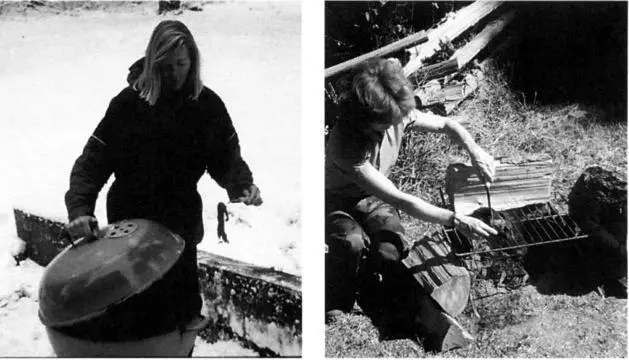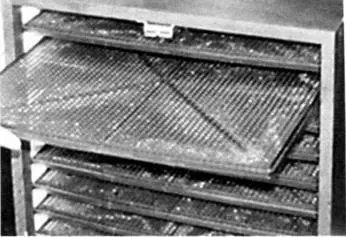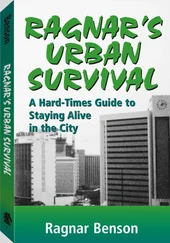Ragnar Benson - Ragnar's Urban Survival - A Hard-Times Guide to Staying Alive in the City
Здесь есть возможность читать онлайн «Ragnar Benson - Ragnar's Urban Survival - A Hard-Times Guide to Staying Alive in the City» весь текст электронной книги совершенно бесплатно (целиком полную версию без сокращений). В некоторых случаях можно слушать аудио, скачать через торрент в формате fb2 и присутствует краткое содержание. Год выпуска: 2009, ISBN: 2009, Жанр: Старинная литература, на английском языке. Описание произведения, (предисловие) а так же отзывы посетителей доступны на портале библиотеки ЛибКат.
- Название:Ragnar's Urban Survival: A Hard-Times Guide to Staying Alive in the City
- Автор:
- Жанр:
- Год:2009
- ISBN:1581600593
- Рейтинг книги:5 / 5. Голосов: 1
-
Избранное:Добавить в избранное
- Отзывы:
-
Ваша оценка:
- 100
- 1
- 2
- 3
- 4
- 5
Ragnar's Urban Survival: A Hard-Times Guide to Staying Alive in the City: краткое содержание, описание и аннотация
Предлагаем к чтению аннотацию, описание, краткое содержание или предисловие (зависит от того, что написал сам автор книги «Ragnar's Urban Survival: A Hard-Times Guide to Staying Alive in the City»). Если вы не нашли необходимую информацию о книге — напишите в комментариях, мы постараемся отыскать её.
Ragnar's Urban Survival: A Hard-Times Guide to Staying Alive in the City — читать онлайн бесплатно полную книгу (весь текст) целиком
Ниже представлен текст книги, разбитый по страницам. Система сохранения места последней прочитанной страницы, позволяет с удобством читать онлайн бесплатно книгу «Ragnar's Urban Survival: A Hard-Times Guide to Staying Alive in the City», без необходимости каждый раз заново искать на чём Вы остановились. Поставьте закладку, и сможете в любой момент перейти на страницу, на которой закончили чтение.
Интервал:
Закладка:
Believe it or not, tough, old, wild fat-free meat makes the best jerky. Far better than fatty, marbled, store-bought steaks or meat of virtually any kind. Any fatty, greasy meat, other than some fish, produces a sticky, rancid, foul-tasting, smelly end product. Fatty fish should be smoked or dried rather than jerked. Generally, fish such as carp, suckers, Kokanee, and dog salmon turn out OK to pretty good when smoked.
Commence the jerky enterprise by cutting thin, lean strips of meat from large cuts taken from the whole carcass. Meat bound for the jerky rack should be sliced no more than 1/2-inch thick. This is a time consuming and often difficult task. Slice across the grain, or at a minimum on the bias across the muscle. Otherwise the finished product may end up tougher than old wang leather.
Plain old charcoal-fired kettle-type barbecue pots or even gas grills work well to jerk meat. Place only three to five live briquettes in the grill. Set gas fires as low as possible. Open all vents, especially in the cover, so that heat from the fire circulates dry, fresh air into the kettle while simultaneously pushing moisture laden air out the top.
Recall again that jerky requires small, gentle heat and air movement. Temperatures of about 175 degrees are about right for those with both thermometer and a by-the-book approach to jerky making.

Meat can be jerked on common kettle-type barbecue grills or even over an open fire.
All jerky will eventually spoil. Insufficiently jerked jerky will spoil more quickly. Last fall we lost several pounds of jerky taken from freezer to refrigerator where we promptly forgot about it. Deterioration was delayed, but eventually it all went badly moldy and stank.
Test jerky as it dries. Properly dried jerky bends nicely before breaking. Cool a piece a bit, and then break it to see how dry it really is. Proper jerky bends to about 90 degrees, then breaks cleanly.
Effective drying takes about 24 to 48 hours over an open fire or out in a bright, hot sun. Kettle barbecues require 6 to 8 hours. Marinating in a brine-and-pepper solution definitely retards spoilage if eating all this extra salt and pepper is otherwise OK. Overjerking is always better than underjerking when longer term storage is an issue.
Finished, jerked meat has lost about two-thirds of its original volume and weight. Although in our society it is seldom used for such, jerky is wonderful reconstituted in soups and stews.
I have very occasionally gone further and made pemmican. Pemmican is an entirely different food. Generally, modern Americans do not appreciate the fatty, lardy mouth feel and taste. Pemmican is assembled from 50 percent finechopped jerky, 25 percent crushed berries or fruit, and 25 percent lard or beef tallow Maybe we will need a shot of calories such as this, but I wonder.

Dehydrating fruits and vegetables is very energy-efficient, leading to a high-quality, nutritious product.
Drying
As mentioned earlier, fish are really dried, not jerked. Use the same heated air circulation system as before, but brine longer with a slightly stronger solution. Dry longer and more thoroughly. Ugly, twisted, almost cardboard-tough fish are probably just about right.
Fruits such as apples, apricots, pears, plums, and peaches can also be dried successfully. Either a commercial drying rack or one made from common bug screen and small pieces of lumber will dry fruit. Processing for the dryer starts with slicing everything into pieces not more than a 1/2-inch thick. Then wash the pieces in a solution of 2 ounces of bleach per gallon of water.
Place treated pieces on the screen or dehydrator rack. Several layers of screen through which warm air is forced are usually most efficient. Again, it needn't be much heat, but movement of heat and air through the rack must occur. Drying takes from 6 to 12 hours. Rotating the pieces on the racks will speed things along a bit. Arrange so the driest are always on top. Properly dried fruit is tough but still a bit malleable. I am told that only 5 percent of food value is lost when drying fruits and vegetables.
The question is, will city survivors have access to sufficient quantities of fruits and perhaps vegetables to make drying feasible? And will there be screen racks and gentle heat needed to accomplish this enterprise? Very few cities in the United States have any fruit trees in their public areas. Too much mess and resulting fuss to keep clean, city fathers claim. City survivors with a scrap of land that will support an apple or plum tree might consider planting. Even if it's a rental property, the cost is only about $25 per tree. Production takes about 4 years.
A few years back a friend with an orchard rigged a canvas-andtin funnel-like affair that channeled natural summer and fall breezes through racks of drying plums and peaches. His simple Rube Goldberg device really worked well. He had lots of fruit, and soon he processed literally tons of apples, peaches, and pears. Other than his labor, it was a free-goods enterprise. Word spread, and he started selling all he could produce.
Vegetables such as peppers, zucchinis, red beets, carrots, and corn can also be dried. They all make pretty good food products that keep well up to 5 years. Coming up with sufficient energy to dry can be a challenge, and it takes lots of rehydration water to bring there back before they can be eaten. Like much of this food rehydrated vegetables are bland and monotonous, but they do keep the tummy full.
Proceed exactly the same as with fruits, but drying vegetables usually takes place more rapidly I personally doubt if survivors will have very many of the above vegetables with exception of carrots and potatoes.
PRESERVING VEGETABLES OUTSIDE
But carrots and potatoes are more easily stored by other methods. In the case of carrots, leave the untreated ones in the ground. Cover them over with a layer of leaves, grass, and duff. In most climates in the continental United States, carrots can be dug and eaten any time till late spring.
Potatoes must have moisture and air moving through them to keep. Some varieties keep much better than others. Red Pontiacs are poor keepers. Spuds with thick, rough-netted skins such as russet Burbanks store quite well. The very best storing potato for survivors is a variety known as Nooksack, named after the Nooksack River in Oregon. They keep like stones. I wish it were otherwise, but this is an obscure variety It is doubtful that even seasoned gardeners will ever be able to find this variety to grow. But here is how to store all kinds of potatoes:
Dig a fairly large hole in the ground 18 inches deep in a welldrained, somewhat sheltered spot. Line this hole with dry grass and leaves. Place a bushel of spuds in the hole on the lining. Cover with a layer of grass and then 4 inches of soil.
Air and moisture from the soil will move through the potatoes, keeping them in nice condition. Only problem is, once the cache of potatoes is opened, they generally must all be taken and used within the next 30 days. Once disturbed, they all go bad relatively quickly
Will city survivors have access to tomatoes? In the unlikely event some come your way, store them for the intermediate term as follows. Clip plants at ground level while green tomatoes are still on the vine. Hang these intact vines from the roof in a sheltered, not particularly warm area Fruit on these vines will slowly ripen, and should be picked from time to time. We have enjoyed fresh, red tomatoes off the vine as late as February after clipping and hanging in October the year previous.
Читать дальшеИнтервал:
Закладка:
Похожие книги на «Ragnar's Urban Survival: A Hard-Times Guide to Staying Alive in the City»
Представляем Вашему вниманию похожие книги на «Ragnar's Urban Survival: A Hard-Times Guide to Staying Alive in the City» списком для выбора. Мы отобрали схожую по названию и смыслу литературу в надежде предоставить читателям больше вариантов отыскать новые, интересные, ещё непрочитанные произведения.
Обсуждение, отзывы о книге «Ragnar's Urban Survival: A Hard-Times Guide to Staying Alive in the City» и просто собственные мнения читателей. Оставьте ваши комментарии, напишите, что Вы думаете о произведении, его смысле или главных героях. Укажите что конкретно понравилось, а что нет, и почему Вы так считаете.











